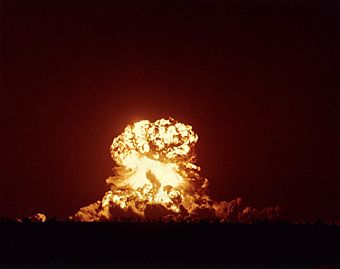Upshot-Knothole Simon facts for kids
Quick facts for kids Upshot–Knothole Simon |
|
|---|---|
 |
|
| Information | |
| Country | United States |
| Test series | Operation Upshot–Knothole |
| Test site | Nevada Test Site |
| Date | 25 April 1953 |
| Test type | Atmospheric |
| Yield | 43 kt |
| Navigation | |
| Previous test | Upshot-Knothole Badger |
| Next test | Upshot-Knothole Encore |
Upshot–Knothole Simon was a nuclear test carried out by the U.S. government. It was part of a bigger series of tests called Operation Upshot–Knothole. The Simon test happened on April 25, 1953, at the Nevada Test Site. During this test, a special type of nuclear weapon, known as the TX-17/24, was exploded. The explosion was quite powerful, with a yield of 43 kilotons.
Contents
What Was the Simon Nuclear Test?
The Simon test was an important part of the Operation Upshot–Knothole series. It took place at 4:30 AM local time on April 25, 1953. The device was placed on a tower about 300 feet (91 meters) tall in Area 1 of the Nevada Test Site. The main goal was to see how well the TX-17/24 weapon design worked.
Unexpected Cloud Movement
After the explosion, a large cloud of radioactive material formed, like a mushroom. However, this cloud did not spread out as much as scientists expected. Instead, it stayed in a small area of the sky and slowly moved towards the east.
How Radiation Affected New York
A couple of days later, this radioactive cloud reached New York State. It got caught in a big thunderstorm over an area known as the Capital District. Most of the radioactive material then fell to the ground in a fairly small region, specifically Washington and Rensselaer counties.
At Rensselaer Polytechnic Institute in Troy, New York, some students were working in a lab that studied radioactive materials. When they turned on their special radiation detectors, called Geiger counters, they found radiation levels that were hundreds of thousands of times higher than normal.
The Discovery and Its Aftermath
Thinking there was a radioactive leak inside their building, the students were quickly moved outside for safety. But to their surprise, the radiation levels outside were even higher! Their professor, Herbert Clark, reported what they found to the Atomic Energy Commission (AEC), which was in charge of nuclear matters.
At first, the AEC did not take Professor Clark's report seriously. Later, he was told to keep quiet about what he had found. He was warned that if he spoke out, he might lose access to important materials from the AEC, or even face serious trouble. This information about the radiation fallout was kept secret for many years. It was finally revealed decades later by a local politician named Samuel S. Stratton.
Images for kids


